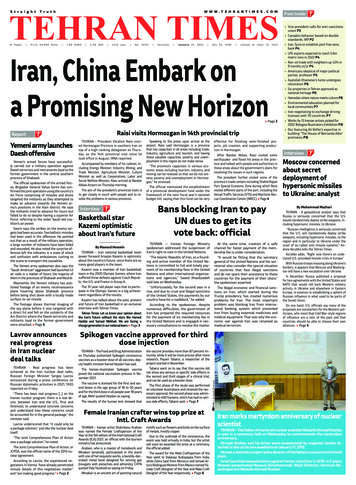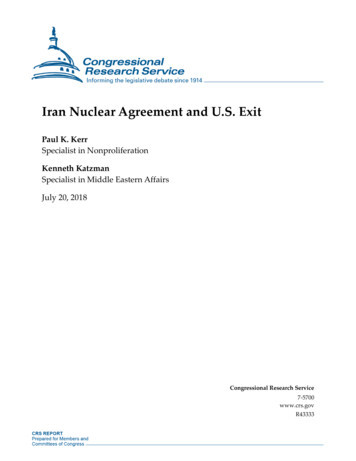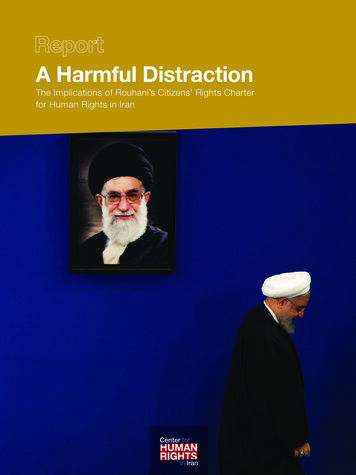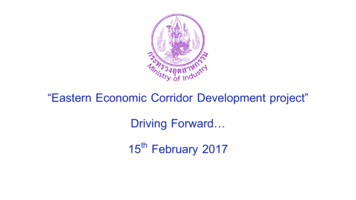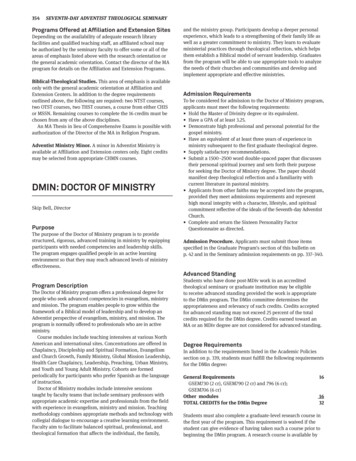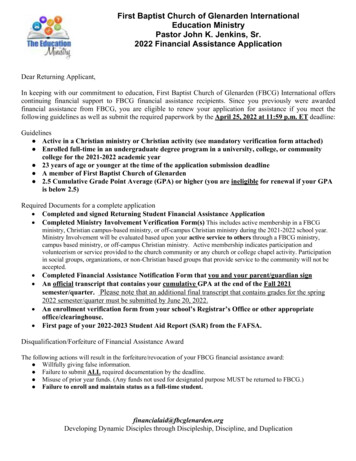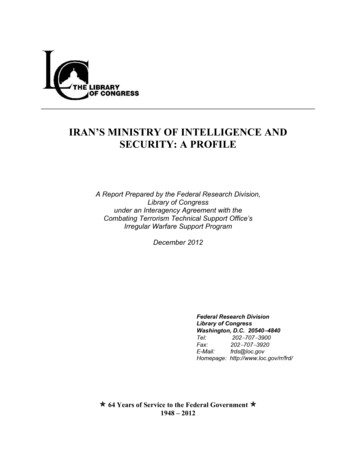
Transcription
A Report Prepared by the Federal Research Division,Library of Congressunder an Interagency Agreement with theCombating Terrorism Technical Support Office’sIrregular Warfare Support ProgramDecember 2012Federal Research DivisionLibrary of CongressWashington, D.C. 20540 4840Tel:202 707 3900Fax:202 707 3920E-Mail:frds@loc.govHomepage: http://www.loc.gov/rr/frd/
This report presents an overview of Iran’s Ministry of Intelligence and Security andattempts to provide an inclusive assessment of the organization, including characteristics such asits history and development, organizational structure, and recruitment.The information in this report was collected mainly from Farsi and English journals,online news Web sites, and Iranian blogs. In conducting this analysis, an effort has been made toensure the reliability of the information by comparing and contrasting all information acrossmultiple sources. However, because of the secretive nature of the organization and its operations,information about the ministry is difficult to locate and evaluate.Because of the extreme degree of control of the media and news by the government of theIslamic Republic of Iran, Iranians have to depend on alternative sources such as blogs to receivedaily news. For example, in 2005 Iran had the third-largest number of bloggers in the world afterthe United States and China, an indication of the importance of the communication anddissemination of news through blogs and social media. Needless to say, the Ministry ofIntelligence and Security does not publish information about its activities on Iranian Web sites.Consequently, in the absence of official government information, this report occasionally relieson social media, in particular blogs, as a source of information more than might ordinarily bewarranted. The reliability of blog-based information may be questionable at times, but it seemsprudent to evaluate and present it in the absence of alternatives.In view of the secrecy that surrounds the ministry, many aspects of its organization,leadership, and activities are poorly understood. The role of the ministry outside of Iran and itscooperation with the Quds Force are topics that merit more careful study. In addition, knowledgeof the ministry’s cyber capabilities would give better insight into Iran’s possible intentions in acyber war.As noted above, this report relies extensively on sources in Farsi. For the convenience ofthe reader, the bibliography and footnotes list those sources with English translations of theirtitles first, followed by the original Farsi titles in brackets. The Web addresses presented in thereport were current as of November 2012.i
PREFACE . i1. EXECUTIVE SUMMARY. 12. GROUP NAMES AND ALIASES . 23. GROUP TYPE . 34. OBJECTIVES . 35. ETHNIC, POLITICAL, AND RELIGIOUS ORIENTATION . 45.1 Ethnic Composition . 45.2 Political Affiliation and Religious and Ideological Orientation . 46. HISTORICAL BACKGROUND. 57. ORGANIZATION . 108. PRINCIPAL LEADERS . 189. HEADQUARTERS . 2310. COMMAND AND CONTROL. 2411. MEMBERSHIP SIZE . 2412. MEMBERSHIP AND RECRUITMENT . 2413. TRAINING AND INDOCTRINATION . 2814. METHODS OF OPERATION AND TACTICS . 2914.1 Operations. 2914.2 Control of Media. 3115. INTELLIGENCE CAPABILITIES . 3215.1 Signals and Cyber Intelligence . 3215.2 Human Intelligence. 3315.3 Counterintelligence. 3316. MOTIVATION AND PERFORMANCE. 3617. PRINCIPAL AREAS OF OPERATION . 3718. FINANCES AND FUND-RAISING. 4019. FOREIGN AFFILIATIONS AND SUPPORT. 4020. USE OF COMMUNICATIONS MEDIA. 4121. TERRORIST THREAT ASSESSMENT . 4422. INFORMATION GAPS (IN SOURCES) . 4523. KEY HISTORICAL EVENTS AND SETBACKS . 4524. CHRONOLOGY OF SIGNIFICANT TERRORIST ATTACKS . 48ii
25. BIBLIOGRAPHY. 5226. APPENDIX. Charts, Maps, and Photos. 62iii
The Ministry of Intelligence and Security (MOIS) uses all means at its disposal to protectthe Islamic Revolution of Iran, utilizing such methods as infiltrating internal oppositiongroups, monitoring domestic threats and expatriate dissent, arresting alleged spies anddissidents, exposing conspiracies deemed threatening, and maintaining liaison with otherforeign intelligence agencies as well as with organizations that protect the IslamicRepublic’s interests around the world.Although Islamist hard-liners in Iran are in charge of the ministry under the guidance ofSupreme Leader Ayatollah Ali Khamenei, the organization encompasses a mixture ofpolitical ideologies.Every minister of intelligence must hold a degree in ijtihad (the ability to interpretIslamic sources such as the Quran and the words of the Prophet and imams) from areligious school, abstain from membership in any political party or group, have areputation for personal integrity, and possess a strong political and managementbackground.According to Iran’s constitution, all organizations must share information with theMinistry of Intelligence and Security. The ministry oversees all covert operations. Itusually executes internal operations itself, but the Quds Force of the IslamicRevolutionary Guards Corps for the most part handles extraterritorial operations such assabotage, assassinations, and espionage. Although the Quds Force operatesindependently, it shares the information it collects with MOIS.The Iranian government considers Mojahedin-e-Khalq to be the organization that mostthreatens the Islamic Republic of Iran. One of the main responsibilities of the Ministry ofIntelligence and Security is to conduct covert operations against Mojahedin-e-Khalq andto identify and eliminate its members. Other Iranian dissidents also fall under theministry’s jurisdiction.The ministry has a Department of Disinformation, which is in charge of creating andwaging psychological warfare against the enemies of the Islamic Republic.Iran’s ability to collect covert information is limited; specifically, its signals intelligencecapability represents only a limited threat because it is still under development.Even though Iran has created a well-equipped counterintelligence system to protect itsnuclear program, it appears that other countries’ operatives still succeed in infiltrating thesystem, as well as some other parts of Iran’s intelligence apparatus.1
The Iranian intelligence service is called the Ministry of Intelligence and Security (MOIS), orVezarat-e Ettela'at va Amniat-e Keshvar (VEVAK) in Farsi. MOIS agents are known as“Unknown Soldiers of Imam Zaman,”1 the name that Ayatollah Khomeini gave them.2Current MOIS EmblemSource: http://cyberarmy.blogfa.comPrevious MOIS EmblemSource: http://www.iranfocus.comThe above left image has been the ministry’s emblem since its establishment. A graphicdesign of Allah (i.e., God) is located at the top. Below the Allah symbol are the words in Farsifor the Islamic Republic of Iran, and, on the bottom, the Ministry of Intelligence. The figure onthe right shows the ministry’s possible new emblem, which has appeared during news programson national television. It forms a star with eight corners (a polygon). In Islamic culture, apolygon is a religious symbol. Two las (la in Arabic means “no” or “not”) on the right and leftside (stylized as pointed salients) are interpreted as “Neither East, nor West, Islamic Republic.”In the center of the star, an eye conveys the role of the ministry as a surveillant of the IslamicRepublic of Iran.1Twelver Shia Muslims believe that Imam Zaman (The Leader of the Age) was appointed by Allah to be the saviorof mankind. Among his many other names, he is also known as “the Mahdi” (The Rightly Guided One). ImanZaman is the Twelfth Imam in the succession of Islamic leaders of Shi’a Muslims.2“Destruction of a Spy Network Linked to the CIA and Detention of 30 American Spies” [30], Fars News Agency [Tehran], May 21, 2011, http://www.farsnews.com/newstext.php?nn 9002315207 (accessed March 20, 2012). Fars News is a semi-official news agency with ties to the Iraniangovernment.2
MOIS is the most powerful and well-supported ministry among all Iranian ministries interms of logistics, finances, and political support. It is a non-military governmental organizationthat operates both inside and outside of Iran. Intelligence experts rank MOIS as one of the largestand most dynamic intelligence agencies in the Middle East.3The current minister of intelligence and security has described his ministry as beinguninfluenced by foreign intelligence services: “One of the characteristics of MOIS is that itformed from inside of the revolution; and in fact, this organization was formed on the basis ofthe needs of the revolution in contrast with other intelligence services around the world thatimitate each other.”4Iran’s constitution defines MOIS’s functions as:collecting, analyzing, producing, and categorizing internal and external intelligence;uncovering conspiracy, subversion, espionage, sabotage, and sedition against theindependence, security, and territorial integrity of the Islamic Republic of Iran;protecting intelligence, news, documents, records, facilities, and personnel of theministry; andtraining and assisting organizations and institutions to protect their significant records,documents, and objects.53“Iran’s Ministry of Intelligence and Security,” Iran Focus [UK], May 6, 2005, http://www.iranfocus.com/en/?option com content&task view&id 2020 (accessed January 31, 2012). Iran focus is a UK-based news Web sitethat provides news on Middle East countries; “Five Major Duties of VAVAK Inside and Outside of the Country,”- ----------.html (accessed MayEnghelab-e-Eslami, 2011, http://enghelabe-eslami.com/5-2880/ 22, 2012). This is the Web site of Abul Hassan Banisadr, the first president of Iran after the Revolution. He had toescape from Iran to save his life. He is now a critic of the Islamic Republic.4“The Minister of Intelligence’s Report of Successes / Outside Opponents and Internal Dissidents of 1388 [2009]Have Become Active Again” [88/], RajaNews [Tehran] (probably 2010 or more recent), http://www.rajanews.com/detail.asp?id 95793 (accessed April 4,2012). Raja News is a conservative Iranian news agency based in Iran that supports the Supreme Leader of Iran.5“Intelligence and Law” [], Jame Jam Online [Tehran], February 11, 2009, http://www.jamejamonline.ir/papertext.aspx?newsnum 100898802936 (accessed April 4, 2012). This conservative Web site isthe Web site of the Islamic Republic of Iran Broadcasting Service (IRIB), which advocates the Supreme Leader’spolicies.3
MOIS’s internal activities are a priority unless it is deemed necessary for MOIS to becomeinvolved directly in external operations. It is possible that the Supreme National Security Councilor the Supreme Leader determines MOIS’s external operations (see Organization, below).MOIS has a proven record of accomplishment in the execution of these functions. In carryingout its constitutional duties, MOIS conducts liaison with other foreign intelligence agencies aswell as with organizations such as Lebanese Hezbollah that protect and promote the IslamicRepublic’s foreign agenda.6As an official Iranian government agency, MOIS is overwhelmingly staffed by Iranians. Itdoes, however, recruit other nationalities for its missions. For example, Anne Singleton, who isBritish, allegedly works for MOIS (see Membership and Recruitment, below).Until the reelection of President Mahmoud Ahmadinejad in 2009, most MOIS personnelwere not uniformly hard-line Islamists, although they were vetted for ideological conformity.For example, in an article on the Fars News Web site in July 2005, the former minister ofintelligence and security, Ghorbanali Dorri Najafabadi, said that when he consulted the formerforeign minister, Ali Akbar Velayati, about whether to accept an offer from PresidentMohammad Khatami (president, 1997–2005) to become head of MOIS, Velayati told him “theMinistry of Intelligence is like a city which is governed by various insights and trends.”7After the reelection of President Ahmadinejad, the country became divided between“reformists”—those Iranians who planned to keep the core values of Iran’s Revolution and tochange the system to include more freedom and democracy—and “hard-liners”—those whoopposed any such changes This division occurred even among officials who formerly heldimportant and sensitive positions. The Ministry of Intelligence and Security was no exception.6Cyrus Maximus, “The Ministry of Intelligence and Security,” Iran Channel, September 16, 2010,http://iranchannel.org/archives/357 (accessed March 21, 2012); Iran Channel criticizes the Iranian government’spolicies. It is unclear where it is based.7“Dorri Najafabadi Spoke About his Selection as the Minister of Intelligence” [], Fars News Agency [Tehran], July 18, 2005, http://www.farsnews.com/newstext.php?nn 8404270109 (accessed March 22, 2012); United Kingdom, Home Office, UK Border Agency, “IRAN: Countryof Origin Information (COI) Report,” June 28, 2011, 39, ments/policyandlaw/coi/iran/report-0611.pdf?view Binary (accessed March 21, 2012).4
Many high-ranking intelligence agents supported Mir Hossein Mousavi, PresidentAhmadinejad’s rival and a reformist. However, the right wing immediately started to removereformist supporters from the ministry. For example, Saeed Hajjarian, a reform theorist andstrategist in Iran, was imprisoned after the 2009 election even though he had been one of thefounders of MOIS after the Revolution.8MOIS operates under the direct supervision of Iran’s Supreme Leader, Ayatollah Khamenei,who claims to be the leader of the Muslim world. As noted above, MOIS agents are known as“Unknown Soldiers of Imam Zaman,” who is the Twelfth Imam in the succession of Islamicleaders of Shi’a Muslims. However, the organization is not bound by Shi’a beliefs. To advanceits goals, MOIS recruits individuals regardless of their beliefs, including Arabs or Jews to spy inIsrael. For example, the deputy minister of MOIS, Saeed Emami, was appointed to a key positionin the ministry because of his family record, despite allegedly being Jewish by birth.9Iran’s intelligence and security system is a difficult subject to study because so littleinformation about it is publicly available. Nevertheless, a review of the history of Iran’sintelligence agencies should lead to a better understanding and an improved assessment of thepresent-day Iranian intelligence apparatus. Iran’s intelligence strategy must be understood in thehistorical context of the Cold War and Iran’s 1979 Revolution. Iran’s intelligence activities arebest divided into two parts: before and after the Revolution.After World War II, Iran became a major player on the side of the West in the Cold War.Consequently, Iran received assistance from Britain and the United States to conduct covertoperations against the Soviet Union, its northern neighbor.In 1957 the United States and Israel cooperated with the shah, Mohammad Reza Pahlavi, tocreate the National Security and Intelligence Organization known as SAVAK (Sazman-eEttela'at va Amniat-e Keshvar). Its objective was to protect the regime from internal opposition.8“Ahmadinejad Is Cleaning Up the Ministry of Intelligence” [!], Our SouthAzerbaijan [Iranian blog], August 2009, http://www.oursouthazerbaijan.com/osa at.htm (accessed April 15, 2012).The reliability of the blog is questionable. “Reza Malek’s Letter, the Former Deputy of the Ministry of Intelligencefrom Evin: Chain, House Arrest, Unknown Graves Will Not Keep Dictatorship [In Power],” Balatarin, May 1,2012, http://balatarin.com/permlink/2012/5/2/3013377 (accessed May 21, 2012). Balatarin is a popular Iraniancommunity Web site, which posts mostly anti-Iranian government news, blogs, etc.9“A Man Called Saeed Emami,” Iran Terror Database, January 22, 2006, http://www.iranterror.com/content/view/178/26/ (accessed March 21, 2012).5
SAVAK was also responsible for ensuring that communists and other leftist party members didnot penetrate the armed forces or other government organizations. Although the mainresponsibility of SAVAK was domestic intelligence, it also engaged in external activities.SAVAK was mostly run by military personnel. After the 1979 Revolution, a published pamphletshowed the scope of SAVAK activities, demonstrating that SAVAK was a full-scale intelligenceagency with 15,000 full-time agents and thousands of part-time informants.10SAVAK initially was created to counter the Tudeh Party (Communist Party in Iransupported by the former Soviet Union), but it gradually expanded its activities and became asophisticated intelligence agency. SAVAK was directly in touch with the Office of the PrimeMinister, and its director was assumed to be the deputy of the prime minister for nationalsecurity affairs. Many well-defined investigative methods were designed to monitor all types ofpolitical activity. SAVAK dedicated a censorship office to monitoring journalists, literaryfigures, and academics across the nation. Many organizations, including universities, laborunions, and peasant organizations, were under intense surveillance by SAVAK. Over time,SAVAK evolved into an organization above the law by acquiring legal authority to arrestassumed antiregime activists, some of whom remained in jail without any record for extendedperiods. As a result, SAVAK earned a worldwide reputation as a brutal intelligence agency.11In the early 1960s, SAVAK’s main concern was the Soviet-allied Tudeh Party and, to alesser extent, other opposition groups, including nationalist, secular, and liberal parties. In theearly 1950s, the Tudeh Party had supported Prime Minister Mohammad Mossadegh because ofhis effort to nationalize Iran’s oil industry. However, this support vanished during the 1953 coupthat was backed by the U.S. Central Intelligence Agency and the British to oust Mossadegh’spopular government. Opposed to a takeover of their oil interests, the British supported OperationAJAX, which helped the shah regain power.12In the early 1960s, the regime successfully suppressed increased protests by the oppositionagainst the shah, with SAVAK silencing dissenters by penetrating their organizations andarresting them. Such was the case with many university students, who after 1963 waged guerrilla10Oliver Jones, “Iran Insights—Iran’s Intelligence and Security Apparatus,” UK Defence Forum, December 2011,2, tusx.pdf (accessed March 22, 2012); Helen Chapin Metz, ed., Iran: A CountryStudy (Washington, DC: GPO for the Federal Research Division, Library of Congress, 1989), http://lcweb2.loc.gov/frd/cs/irtoc.html (accessed May 2, 2012).11Metz, ed., Iran: A Country Study.6
warfare against the shah’s regime. The same was true of the communist group “FadayiGuerrilla,” which received training from the Popular Front for the Liberation of Palestine andother groups affiliated with the Palestine Liberation Organization (PLO). SAVAK also closelymonitored dissident students abroad and plotted assassinations of opposition figures in exile.13After the 1979 Islamic Revolution, Iranian intelligence functioned like intelligenceorganizations in every other revolutionary country—it identified and eradicated opponents anddefectors inside and outside of the country. Thus, collecting information was not the priority. Atthis time, the PLO was providing the most foreign information to the Iranian government.However, the Soviet KGB allegedly used this exchange of information to feed the revolutionarygovernment inaccurate information as a way of complicating the United States–Iran relationshipmore than was already the case after the Revolution.14From the beginning of the Revolution in 1979, internal security was in the hands of IslamicRevolutionary Kumitehs (literally, committees), which Ayatollah Khomeini ordered to beformed because of concerns that a police force might be more loyal to the shah than to the newrevolutionary regime. People established Kumitehs in their neighborhoods in places such aspolice stations, mosques, and youth centers. In addition to having responsibility for security,each Kumiteh had a unit to gather information (intelligence) on its neighbors. AyatollahMohammad Reza Mahdavi Kani, who was one of the revolutionaries close to AyatollahKhomeini, was in charge of the Kumitehs. Kumitehs may have operated under the Ministry ofInterior.15 Other groups were involved in gathering information as well, including judges whowere in charge of cases dealing with sabotage by opposition groups and with counterintelligence.The interim government and the Revolutionary Council formed by Ayatollah Khomeini tolead the Revolution while he was exiled in Paris endeavored to revive parts of SAVAK,especially its eighth directorate, a counterintelligence unit in charge of monitoring foreignembassies and detecting espionage. This directorate focused on Eastern Bloc countries, inparticular the Soviet Union, and Arab states. After the Revolution, Dr. EbrahimYazdi, the first12Jones, “Iran Insights—Iran’s Intelligence and Security Apparatus,” 2.Jones, “Iran Insights—Iran’s Intelligence and Security Apparatus,” 3.14Jones, “Iran Insights—Iran’s Intelligence and Security Apparatus,” 4.15“Untold [Incidents] About the Ministry of Intelligence” [], Aftab News [Tehran],September 6, 2005, http://www.aftabnews.ir/vdcc4xqs.2bqii8laa2.html (accessed May 18, 2012). Aftab News is anews Web site based in Iran, with a pro-government viewpoint.137
minister of the revolution, broadened the directorate’s jurisdiction by focusing on more countriesand by continuing to use SAVAK personnel.16In 1979–80 the revolutionary government created a variety of small agencies, but the mostdistinctive and prestigious was the National Intelligence and Security Agency (Sazman Ettela’atva Amniat Melli Iran—SAVAMA). It was built on SAVAK’s foundation. SAVAMAsuccessfully used the same methods as SAVAK to collect foreign intelligence, while the IslamicRevolutionary Guards Corps (IRGC) was established to guard the Revolution and deal withdomestic threats. Later, the IRGC became involved in foreign intelligence operations.17The Iranian intelligence apparatus operated relatively successfully at the beginning of therevolutionary era. In July 1980, it uncovered the Nojeh Coup, an attempt to overthrow the newgovernment by air force officers loyal to the shah. Then, the number of security and intelligenceagencies increased dramatically, causing disorder in the intelligence system. As a consequence,Mohammad Ali Rajaei, the second president of the Islamic Republic of Iran, formed the PrimeMinister’s Intelligence Office (Daftar-e- Ettela’at Nokhostvaziri) in 1981. At this time,intelligence responsibilities were divided among the Prime Minister’s Intelligence Office, theIRGC, the army, the Kumitehs, and the police force.18In August 1983, parliament approved the formation of the Islamic Republic of Iran’sMinistry of Intelligence and Security by merging three organizations that had had fourcontinuous years of experience in dealing with foreign intelligence services and confrontingantirevolutionary groups. The three intelligence organizations, which had been operatingseparately since 1979, were IRGC intelligence, the Kumitehs, and the Prime Minister’sIntelligence Office. At that time, many former SAVAK agents were granted amnesty byreligious leaders so that MOIS could benefit from their experience. Specifically, SAVAK agentswere needed to boost Iran’s intelligence capacity to deal with the war with Iraq in the 1980s.1916“Untold [Incidents] About the Ministry of Intelligence,” [].Jones, “Iran Insights—Iran’s Intelligence and Security Apparatus,” 4.18“Untold [Incidents] About the Ministry of Intelligence,” [].19“Untold [Incidents] About the Ministry of Intelligence,” []; Amir Farshad Ebrahimi,“Who Is Saeed Emami?” [()], Hokoomat Nezami [Iranian blog], May 10, 2008,http://gavras.wordpress.com/2008/05/10/% %85%DB%8C-%D8%A7% %9F-%D8%A7%D9%85% 8%A8/ (accessed May 18, 2012).178
The new ministry was charged with the development of a strong intelligence capability thatcould confront the intelligence agencies of Iran’s enemies. These foreign agencies had penetratedantirevolutionary groups, and some had also infiltrated vital parts of the government during theIran–Iraq war. Furthermore, the government had to deal with dissidents outside of the countrywho constantly opposed the Iranian government.20Targeting externally based Iranian opponents of the Revolution was one of the mainobjectives of MOIS in the 1990s. The ministry was responsible for many terrorist attacks andassassinations of dissidents during this decade, such as the assassination of Shahpour Bakhtiar(the last prime minister under the shah). MOIS agents also were directly involved in thecollection of information for the possible assassination of Salman Rushdie, an Indian-born authorwho wrote The Satanic Verses. Because of the alleged un-Islamic content of the book, AyatollahKhomeini issued a fatwa in February 1989 calling on all good Muslims to kill Rushdie and hispublishers. The assassination of four Iranian-Kurdish members of the Iranian Democratic Partyof Kurdistan in Berlin at a Greek restaurant named “Mykonos” in 1992 received internationalattention. Kurds and other minority ethnic groups such as Baluchis, Turks, and Arabs comeunder MOIS’s surveillance because these peoples seek independence from the centralgovernment.21The “Chain Murders” in Iran were a series of assassinations that took place in the 1990s tosilence Iranian dissident intellectuals. After an investigation, MOIS took responsibility for themurders by proclaiming that some of its agents committed these crimes without its awareness(see Key Historical Events and Setbacks, below). An Argentine court also blamed MOIS forenlisting Hezbollah to bomb the Israeli embassy and the Jewish center in Buenos Aires in 1992and 1994.22 However, the IRGC was responsible for these incidents, although MOIS certainly20“How Did the Ministry of Intelligence Form?” [], Khanevadeh Kooch [Iranianblog, Tehran], March 1, 2011, http://www.koooch.com/thread1703.html (accessed March 22. 2012).21“Five Major Duties of VAVAK Inside and Outside of the Country”; “Mostafa Poormohammadi: I Had No Role inChain Murders” [.:], BBC Persian, February 27, 2012), http://www.bbc.co.uk/persian/iran/2012/02/120227 l32 pourmohamadi iranian murder.shtml (accessed May 17 2012); AlisonFlood, “Salman Rushdie Reveals Details of Fatwa Memoir,” Guardian [Manchester], April 12, 2012, -rushdie-reveals-fatwa-memoir (accessed May 19, 2012); “SecretExecution of Four Arab Political Prisoners” [:], Gooya News, June 21, 2012, http://news.gooya.com
This report presents an overview of Iran's Ministry of Intelligence and Security and attempts to provide an inclusive assessment of the organization, including characteristics such as its history and development, organizational structure, and recruitment. The information in this report was collected mainly from Farsi and English journals,
